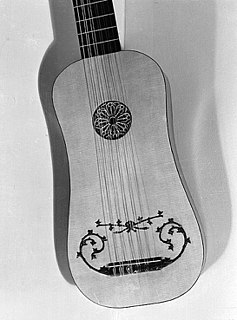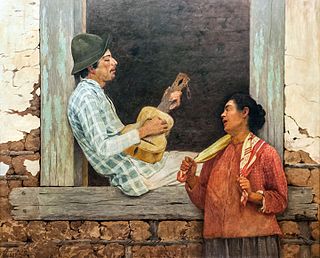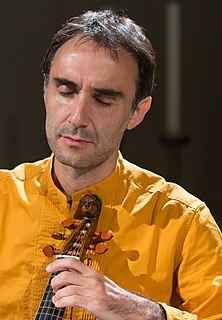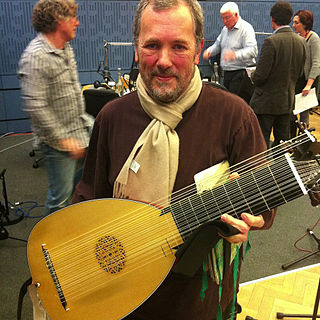
Frank Underwood is an English folk and blues musician who is also known for his work in the early music field. He lives and works in Oxfordshire, England.

Frank Underwood is an English folk and blues musician who is also known for his work in the early music field. He lives and works in Oxfordshire, England.
Frank Underwood learned classical piano as a boy and classical guitar in his teens. He also plays harpsichord, organ, lute and viola da gamba. [1] He was the leader of the 1970s London-based band Windsong, which featured Annie Lennox prior to her involvement with The Tourists and fame with the Eurythmics. In the early 1980s he played guitar and sang in a folk/ragtime/blues duo in north Oxfordshire, England, with fiddler David Favis-Mortlock, performing as 'Mortlock and Underwood'. From 1983 to 1986 he was singer, guitarist and harmonica player in the 'Band of Minstrels', a four-piece acoustic folk/blues/renaissance group in north Oxfordshire.
He plays and has taught guitar, harmonica and lute. [1] A strong interest in the cultural life of England at the time of Jane Austen led him to establish an Austen group [2] in Oxford, [3] [4] and to team up with Gillian Tunley in an ensemble called 'Austentation', [5] since augmented by the addition of Angela Mayorga on guitar and voice, and other guests. [6]
Underwood studied lute in Oxford with Lynda Sayce and Edward FitzGibbon, and viol with Susanne Heinrich. [1] He played lute, harpsichord and viola da gamba in Oxford-based Early Music consorts Westron Wynd and La Joysance. [1] He has been invited over the course of several years to play keyboards at Jane Austen festivals in Bath, England. [6]
Underwood was commissioned to write and perform music to honour the 1980s UK visit of Bishop Desmond Tutu of South Africa, and has become known as a performer at festivals and cultural events in Oxfordshire.
He has released three CDs of mixed folk, mediaeval material, blues and his own songs, recorded at Oxford-based Folly Bridge Records: "In Retrospect" (2000), "Highway Songs" (2001) and "Possession" (2003). [1]

The viol, viola da gamba, or informally gamba, is any one of a family of bowed, fretted and stringed instruments with hollow wooden bodies and pegboxes where the tension on the strings can be increased or decreased to adjust the pitch of each of the strings. Frets on the viol are usually made of gut, tied on the fingerboard around the instrument's neck, to enable the performer to stop the strings more cleanly. Frets improve consistency of intonation and lend the stopped notes a tone that better matches the open strings. Viols first appeared in Spain in the mid to late 15th century and were most popular in the Renaissance and Baroque (1600–1750) periods. Early ancestors include the Arabic rebab and the medieval European vielle, but later, more direct possible ancestors include the Venetian viole and the 15th- and 16th-century Spanish vihuela, a 6-course plucked instrument tuned like a lute that looked like but was quite distinct from the 4-course guitar.

String instruments, stringed instruments, or chordophones are musical instruments that produce sound from vibrating strings when the performer plays or sounds the strings in some manner.

The vihuela is a 15th-century fretted plucked Spanish string instrument, shaped like a guitar but tuned like a lute. It was used in 15th- and 16th-century Spain as the equivalent of the lute in Italy and has a large resultant repertory. There were usually five or six doubled strings.
Stephen Cuthbert Vivian Dodgson was a British composer and broadcaster. Dodgson's prolific musical output covered most genres, ranging from opera and large-scale orchestral music to chamber and instrumental music, as well as choral works and song. Three instruments to which he dedicated particular attention were the guitar, harpsichord and recorder. He wrote in a mainly tonal, although sometimes unconventional, idiom. Some of his works use unusual combinations of instruments.
Accent Records is a Belgian record label started in 1979 by Adelheid and Andreas Glatt, a German Instrument maker, releasing classical music from between 1500 AD and the 20th century, but primarily from the 17th and 18th centuries. Andreas Glatt has also worked as a sound engineer on other Belgian labels, such as Eufoda.

Eugène Arnold Dolmetsch, was a French-born musician and instrument maker who spent much of his working life in England and established an instrument-making workshop in Haslemere, Surrey. He was a leading figure in the 20th-century revival of interest in early music.

A folk instrument is a musical instrument that developed among common people and usually does not have a known inventor. It can be made from wood, metal or other material. Such an instrument is played in performances of folk music.

The lirone is the bass member of the lira family of instruments that was popular in the late 16th and early 17th centuries. It is a bowed string instrument with between 9 and 16 gut strings and a fretted neck. When played, it is held between the legs in the manner of a cello or viol.
Hille Perl is a German virtuoso performer of the viola da gamba and lirone. She is considered to be one of the world's finest viola da gamba players, specializing in solo and ensemble music of the 17th and 18th centuries. She has a particular interest in French Baroque repertoire for seven-string bass viola da gamba. She also performs Spanish, Italian, German, and modern repertoire for the instrument and has released many CDs.
David T. Favis-Mortlock is an English geomorphologist and musician.
Viola bastarda refers to a highly virtuosic style of composition or extemporaneous performance, as well as to the altered viols created to maximize players' ability to play in this style. In the viola bastarda style, a polyphonic composition is reduced to a single line, while maintaining the same range as the original, and adding divisions, improvisations, and new counterpoint. The style flourished in Italy in the late 16th and early 17th centuries. Francesco Rognoni, a prominent composer of divisions, stated that although works using the bastarda techniques could be played by a number of instruments, including organ, lute, and harp, the "queen" of bastarda technique was the viol because of its agility and large range.
The Harp Consort is an international early music ensemble directed by Andrew Lawrence-King, specialising in Baroque opera, early dance-music, and historical World Music.

Vittorio Ghielmi is an Italian musician, conductor, compose Compared by critics to Jasha Heifetz (“Diapason”) for his virtuosity, and described as “An Alchemist of sound” for the intensity and versatility of his musical interpretations, Vittorio Ghielmi attracted notice while still very young for his new approach to the viola da gamba and to the sound of early music repertoire. He is Professor for viola da gamba and Head of the Institut für Alte Musik at the Mozarteum Universität Salzburg and Visiting Professor at the Royal College of London. He is graduate at the Università Cattolica di Milano.

Nigel North is an English lutenist, musicologist, and pedagogue.

The Sonata in E major for flute and basso continuo is a sonata for transverse flute and figured bass composed by J. S. Bach in the 1740s. It was written as the result of a visit in 1741 to the court of Frederick the Great in Potsdam, where Bach's son Carl Philipp Emanuel had been appointed principal harpsichordist to the king the previous year. It was dedicated to Michael Gabriel Fredersdorf, the king's valet and private secretary, who, like the king, was an amateur flautist.
Rob MacKillop is a Scottish composer and multi-instrumentalist, specializing in lute, theorbo, vihuela, banjo, ukulele and both classical and Russian guitar. He is an important performer of Early Music in Scotland. He is also a photographer.
Desmond John Dupré was an English lutenist, guitarist, gambist and a prominent figure in the 20th century revival of early music. He was known particularly for his recordings on lute and viola da gamba, notably with counter-tenor Alfred Deller.
Felicia Donceanu is a Romanian painter, sculptor and composer.
The Texas Early Music Project is a performing arts ensemble based in Austin, Texas, that focuses on bringing audiences a closer knowledge and appreciation of Baroque music, Medieval music, Renaissance music, and early Classical-period music. The group uses historical instruments in keeping with historically informed performance practice. The ensemble was founded in 1987 by Daniel Johnson, who remains the group's artistic director. The group is classified as a non-profit organization and operates primarily on grant money and donations for individual and corporate supporters. Income is supplemented by ticket sales and merchandise sales. Texas Early Music Project is a member of Early Music America. Performers are primarily professional musicians from the Austin area, although performers visit from Texas at large, from all over the United States, and occasionally internationally.